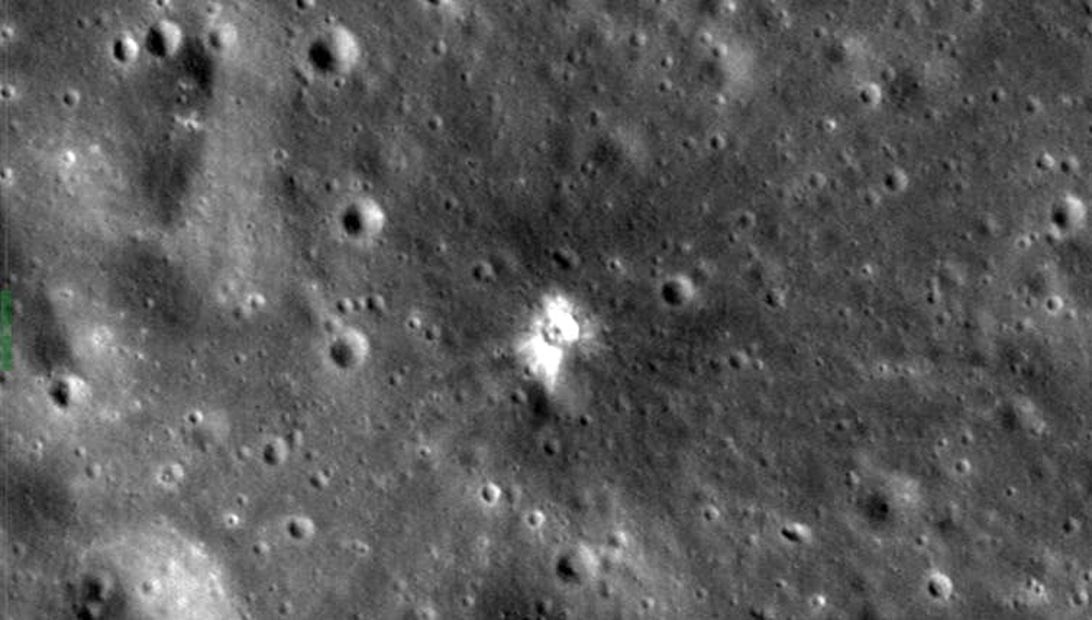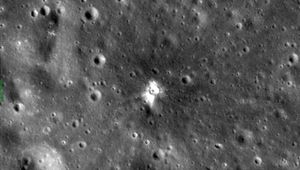
NASA/Goddard Space Flight Center/Arizona State University
Someone check with Elon Musk to see about turning on the cameras on that old Falcon 9….
While the impact and the new crater it creates won’t be visible from Earth, Gray and others are hopeful the Lunar Reconnaissance Orbiter and other spacecraft will eventually be able to get a glimpse of the damage.
“So I’m not bothered by one more crater being made on the moon,” David Rothery, professor of planetary geosciences at the UK’s Open University, wrote in The Conversation. “It already has something like half a billion craters that are 10 meters or more in diameter. What we should worry about is contaminating the moon with living microbes, or molecules that could in the future be mistaken as evidence of former life on the moon.”
SpaceX did not immediately respond to a request for comment. “In essence, this is a ‘free’ Lcross… except we probably won’t see the impact,” Gray says.
A natural impact on the moon created this crater in 2013. It’s about to get another.
Bill Gray, an amateur astronomer and software developer in Maine, first noticed the terminal trajectory. His software picked up the impact in an orbital model and Gray worked with observatories around the world to gather additional data and increase his confidence in the prediction.
“It will be the moon’s newest archaeological site,” writes space archaeologist Alice Gorman. “We’ll learn something about the geology of the location from the color differences and distribution of the ejected material. It’s an opportunity to learn more about the Moon’s mysterious far side.”
The rocket launched from Florida in 2015, lofting the Deep Space Climate Observatory satellite into orbit before continuing into its own rather erratic elliptical orbit.
“With all the data, we’ve got a certain impact at March 4 12:25:58 Universal Time (4:25 a.m. PT),” Gray writes in a blog post. Jonathan McDowell, a leading watcher of orbit and everything near Earth in space, confirmed the prediction.
For those asking: yes, an old Falcon 9 second stage left in high orbit in 2015 is going to hit the moon on March 4. It’s interesting, but not a big deal.
— Jonathan McDowell (@planet4589) January 25, 2022
The remains of the upper stage from a SpaceX Falcon 9 rocket will go on an unplanned extended mission next month when the roughly 4-ton hunk of space junk creates a new crater on the moon’s far side by slamming into it at over 5,000 miles per hour.
Unlock the biggest mysteries of our planet and beyond with the CNET Science newsletter. Delivered Mondays.
Gray expects the spent rocket to crash into the lunar surface in a crater named Hertzsprung that’s a little bit larger than the state of Iowa. The location is remote enough that the impact doesn’t pose any threat to the Apollo mission or other space program landing sites.
In a case of cosmic irony, Gray points out there’s one spacecraft well positioned to view the impact: the Deep Space Climate Observatory, the same satellite that the wayward rocket launched seven years ago.
“Except that it’s about 600,000 kilometers (373,000 miles) away, and tends to stay focused on the Earth; I don’t expect they would swerve it sideways to observe an impact that would probably be too faint for it to observe anyway.”





